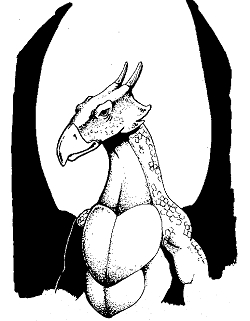HAWKDRAGON
by Richard Stump

FREQUENCY: Very rare
NO. APPEARING: 1 (1-3 in wild)
ARMOR CLASS: 4
MOVE: 12?/33" (MC: B)
HITDICE: 1 +1 to 3 +3
% IN LAIR: Nil (50% in wild)
TREASURE TYPE: See below
NO. OF ATTACKS: 4
DAMAGE/ATTACK: 1-2/1-2/1-4/1-2
SPECIAL ATTACKS: Diving attack,
breath weapon
SPECIAL DEFENSES: Immunity to
missiles
MAGIC RESISTANCE: Standard
INTELLIGENCE: Low to average
ALIGNMENT: Neutral
SIZE: S (11/2? to 3%? long)
PSIONIC ABILITY: Nil
Attack/Defense Modes: Nil
LEVEL/X.P. VALUE: III to IV/126
+ 2/hp to 240 + 4/hp
The hawkdragon is a rare creature that
dwells in forests and wooded hills.
Named
because of its similarity in size and appear-
ance to a hawk, it is quick on the ground
and capable of highly complicated maneu-
vers in the air.
Most hawkdragons are found in the wild,
but occasionally one domesticated from
birth may be found as the pet of a powerful
or wealthy lord. As hawkdragons are small,
fast, and vicious, domesticated ones have
been used much in the same manner as
falcons for sport.
A hawkdragon attacks with a claw/claw/
bite/tail slash routine, getting all four at-
tacks even while airborne, as the tiny
hawkdragon can land upon larger prey to
attack. Since they can fly so well, 70% of all
hawkdragons are able to dive on a target in
the same manner that eagles do. During a
dive, a hawkdragon can only attack with its
claws and tail, but all hits are at +4 on the
die, damage is doubled, and a ?to hit? roll
of 20 indicates a 50% chance of blinding the
victim in one eye. A heal alone will cure
this blindness.
Hawkdragons, due to an innate form of
magic resistance coupled with their high
maneuverability, are not affected by normal
missile weapons of any kind, and magical
arrows or bolts do -1 damage on each die
(see 3rd-level magic-user spell, protection
from normal missiles). The -1 modifier also
applies to missiles from ballistas, catapults,
and the like, but this resistance offers no
protection to the magic missile spell.
If a hawkdragon attacks a creature that is
too powerful for it or if the creature is badly
wounded, it will use its breath weapon of a
10? -diameter stinking cloud, centered on
the dragon?s nose. A missed saving throw
vs. spell constitutes nausea (and the inabil-
ity to attack) for 2-5 rounds, just long
enough for the hawkdragon to flee. It is
thought that some hawkdragons eat various
wild herbs and onions to intensify this ef-
fect. A hawkdragon is immune to its own
breath weapon and can use it twice a day.
Wild hawkdragons have a natural affinity
for brightly colored objects, so their nests
may contain treasure types K, L, M, and
1-4 small gems (base 10 gp value). Domesti-
cated hawkdragons often wear either a
silver, gold, or gem-studded collar bestowed
upon them by their masters.
When encountered in the wild, a
hawkdragon will be either a lone male, a
mated pair, or a mated pair and young.
There is a 40% chance that a mated pair of
hawkdragons also has a clutch of 1-3 eggs.
If sold, hawkdragon eggs can bring over
1,000 gp on the market, and young 3,000
gp. Adult hawkdragons will defend their
eggs or young to the death, and cannot be
subdued.
Hawkdragons range in color from dark
green for young ones to brown for adult
ones. They are sized and gain hit points as
do normal dragons; i.e., an 8-sided die is
rolled: 1-2 = small (1 + 1 HD), 3-7 =
average (2 + 2 HD), 8 = large (3 + 3 HD).
Ancient hawkdragons live to be 140 years
old, and each growth stage is as follows:
| Very young |
0-3 years |
| Young |
4-7 years |
| Sub-adult |
8-18 years |
| Young adult |
19-30 years |
| Adult |
31-60 years |
| Old |
61-90 years |
| Very old |
91-120 years |
| Ancient |
121+ years |